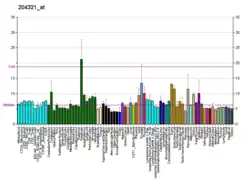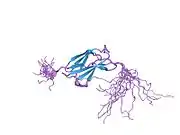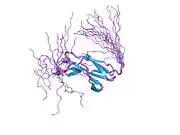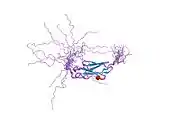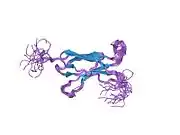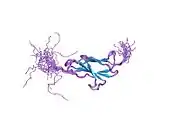NEO1
Neogenin is a protein that in humans is encoded by the NEO1 gene.[5][6]
| NEO1 | |||||||||||||||||||||||||||||||||||||||||||||||||||
|---|---|---|---|---|---|---|---|---|---|---|---|---|---|---|---|---|---|---|---|---|---|---|---|---|---|---|---|---|---|---|---|---|---|---|---|---|---|---|---|---|---|---|---|---|---|---|---|---|---|---|---|
 | |||||||||||||||||||||||||||||||||||||||||||||||||||
| |||||||||||||||||||||||||||||||||||||||||||||||||||
| Identifiers | |||||||||||||||||||||||||||||||||||||||||||||||||||
| Aliases | NEO1, IGDCC2, NGN, NTN1R2, neogenin 1 | ||||||||||||||||||||||||||||||||||||||||||||||||||
| External IDs | OMIM: 601907 MGI: 1097159 HomoloGene: 1870 GeneCards: NEO1 | ||||||||||||||||||||||||||||||||||||||||||||||||||
| |||||||||||||||||||||||||||||||||||||||||||||||||||
| |||||||||||||||||||||||||||||||||||||||||||||||||||
| |||||||||||||||||||||||||||||||||||||||||||||||||||
| |||||||||||||||||||||||||||||||||||||||||||||||||||
| |||||||||||||||||||||||||||||||||||||||||||||||||||
| Wikidata | |||||||||||||||||||||||||||||||||||||||||||||||||||
| |||||||||||||||||||||||||||||||||||||||||||||||||||
Interactions
NEO1 has been shown to interact with PTK2.[7] Also Neogenin receptor is pointed as a component of the mechanisms that determine skeletal cell fusion via RGMa (repulsive guidance molecule a) binding. [8]
References
- GRCh38: Ensembl release 89: ENSG00000067141 - Ensembl, May 2017
- GRCm38: Ensembl release 89: ENSMUSG00000032340 - Ensembl, May 2017
- "Human PubMed Reference:". National Center for Biotechnology Information, U.S. National Library of Medicine.
- "Mouse PubMed Reference:". National Center for Biotechnology Information, U.S. National Library of Medicine.
- Meyerhardt JA, Look AT, Bigner SH, Fearon ER (Apr 1997). "Identification and characterization of neogenin, a DCC-related gene". Oncogene. 14 (10): 1129–36. doi:10.1038/sj.onc.1200935. PMID 9121761.
- "Entrez Gene: NEO1 neogenin homolog 1 (chicken)".
- Ren XR, Ming GL, Xie Y, Hong Y, Sun DM, Zhao ZQ, Feng Z, Wang Q, Shim S, Chen ZF, Song HJ, Mei L, Xiong WC (Nov 2004). "Focal adhesion kinase in netrin-1 signaling". Nat. Neurosci. 7 (11): 1204–12. doi:10.1038/nn1330. PMID 15494733. S2CID 2901216.
- Do Carmo Costa, Alinne; Copola, Aline Gonçalves Lio; Carvalho e Souza, Clara; Nogueira, Júlia Meireles; Silva, Gerluza Aparecida Borges; Jorge, Erika Cristina (2021). "RGMa can induce skeletal muscle cell hyperplasia via association with neogenin signalling pathway". In Vitro Cellular & Developmental Biology - Animal. 57 (4): 415–427. doi:10.1007/s11626-021-00555-9. PMID 33748906. S2CID 232311370.
Further reading
- Vielmetter J, Kayyem JF, Roman JM, Dreyer WJ (1995). "Neogenin, an avian cell surface protein expressed during terminal neuronal differentiation, is closely related to the human tumor suppressor molecule deleted in colorectal cancer". J. Cell Biol. 127 (6 Pt 2): 2009–20. doi:10.1083/jcb.127.6.2009. PMC 2120299. PMID 7806578.
- Keino-Masu K, Masu M, Hinck L, Leonardo ED, Chan SS, Culotti JG, Tessier-Lavigne M (1996). "Deleted in Colorectal Cancer (DCC) encodes a netrin receptor". Cell. 87 (2): 175–85. doi:10.1016/S0092-8674(00)81336-7. PMID 8861902.
- Vielmetter J, Chen XN, Miskevich F, Lane RP, Yamakawa K, Korenberg JR, Dreyer WJ (1997). "Molecular characterization of human neogenin, a DCC-related protein, and the mapping of its gene (NEO1) to chromosomal position 15q22.3-q23". Genomics. 41 (3): 414–21. doi:10.1006/geno.1997.4688. PMID 9169140.
- Wang H, Copeland NG, Gilbert DJ, Jenkins NA, Tessier-Lavigne M (1999). "Netrin-3, a mouse homolog of human NTN2L, is highly expressed in sensory ganglia and shows differential binding to netrin receptors". J. Neurosci. 19 (12): 4938–47. doi:10.1523/JNEUROSCI.19-12-04938.1999. PMC 6782680. PMID 10366627.
- Srinivasan K, Strickland P, Valdes A, Shin GC, Hinck L (2003). "Netrin-1/neogenin interaction stabilizes multipotent progenitor cap cells during mammary gland morphogenesis". Dev. Cell. 4 (3): 371–82. doi:10.1016/S1534-5807(03)00054-6. PMID 12636918.
- Ho SM, Lau KM, Mok SC, Syed V (2003). "Profiling follicle stimulating hormone-induced gene expression changes in normal and malignant human ovarian surface epithelial cells". Oncogene. 22 (27): 4243–56. doi:10.1038/sj.onc.1206437. PMID 12833147.
- Matsunaga E, Tauszig-Delamasure S, Monnier PP, Mueller BK, Strittmatter SM, Mehlen P, Chédotal A (2004). "RGM and its receptor neogenin regulate neuronal survival". Nat. Cell Biol. 6 (8): 749–55. doi:10.1038/ncb1157. PMID 15258591. S2CID 15433313.
- Ren XR, Ming GL, Xie Y, Hong Y, Sun DM, Zhao ZQ, Feng Z, Wang Q, Shim S, Chen ZF, Song HJ, Mei L, Xiong WC (2005). "Focal adhesion kinase in netrin-1 signaling". Nat. Neurosci. 7 (11): 1204–12. doi:10.1038/nn1330. PMID 15494733. S2CID 2901216.
- Lee JE, Kim HJ, Bae JY, Kim SW, Park JS, Shin HJ, Han W, Kim SW, Kang KS, Noh DY (2006). "Neogenin expression may be inversely correlated to the tumorigenicity of human breast cancer". BMC Cancer. 5: 154. doi:10.1186/1471-2407-5-154. PMC 1322231. PMID 16324219.
- Liu T, Qian WJ, Gritsenko MA, Camp DG, Monroe ME, Moore RJ, Smith RD (2006). "Human plasma N-glycoproteome analysis by immunoaffinity subtraction, hydrazide chemistry, and mass spectrometry". J. Proteome Res. 4 (6): 2070–80. doi:10.1021/pr0502065. PMC 1850943. PMID 16335952.
This article is issued from Wikipedia. The text is licensed under Creative Commons - Attribution - Sharealike. Additional terms may apply for the media files.




